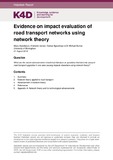| dc.contributor.author | Sasidharan, Manu | |
| dc.contributor.author | Usman, Kristianto | |
| dc.contributor.author | Ngezahayo, Esdras | |
| dc.contributor.author | Burrow, Michael | |
| dc.date.accessioned | 2019-09-27T09:51:20Z | |
| dc.date.available | 2019-09-27T09:51:20Z | |
| dc.date.issued | 2019-08-21 | |
| dc.identifier.citation | Sasidharan, M., Usman, K., Ngezahayo. E & Burrow, M. P. N. (2019). Evidence on impact evaluation of transport networks using network theory. K4D Helpdesk Report. Brighton, UK: Institute of Development Studies. | en |
| dc.identifier.uri | https://opendocs.ids.ac.uk/opendocs/handle/20.500.12413/14712 | |
| dc.description.abstract | The development of network theory has resulted in a growing understanding of the topological properties of transport networks. This has led to knowledge on how network indicators relate to the performance of a network, their wider socio-economic impacts and insights about how networks can best be extended. It has also provided transport planners with an insight into traffic flow, travel demand, centrality and connectivity of transport networks. This rapid evidence-review summarises literature (1999-2019) that have used network theory to evaluate the impact evaluation of road networks, it also presents the technological advancements in network theory. The identified studies outline the beneficial impacts of road networks on the economy, how connectivity can be improved to improve network resilience, reliability, performance and reduce maintenance costs. A number of studies describe how networks can be designed to reduce the impact on the environment. However, with the exception of only three studies i.e Kumar and Kumar (1999), Vasas and Magura et al. (2009) and Walker et al. (2013), the impacts are not quantified. The magnitude of the impact, for a particular network, is a function of the type of model used. As studies could not be found where different models have been used to assess similar impacts, it was not possible to compare numerically the impacts of different model types.
Enhancements to network theory have focused on (i) developing new measures and indicators to assess connectivity, vulnerability and economic impact of transport networks, (ii) applying weightages to nodes and links to evaluate economic and ecological impacts and (iii) developing multiple layers within the network models for better spatial analysis. Recent studies have also expanded network theory and integrated it with risk modelling and probabilistic methodologies to identify vulnerable or critical elements within a given transport network. | en |
| dc.language.iso | en | en |
| dc.publisher | IDS | en |
| dc.relation.ispartofseries | K4D Helpdesk Report;652 | |
| dc.rights.uri | https://www.nationalarchives.gov.uk/doc/open-government-licence/version/3/ | en |
| dc.subject | Economic Development | en |
| dc.subject | Rural Development | en |
| dc.subject | Technology | en |
| dc.title | Evidence on Impact Evaluation of Road Transport Networks using Network Theory | en |
| dc.type | Helpdesk | en |
| dc.rights.holder | © DFID - Crown copyright 2019 | en |
| dcterms.dateAccepted | 2019-08-21 | |
| rioxxterms.funder | Department for International Development, UK Government | en |
| rioxxterms.identifier.project | K4D | en |
| rioxxterms.version | VoR | en |
| rioxxterms.funder.project | 238a9fa4-fe4a-4380-996b-995f33607ba0 | en |

